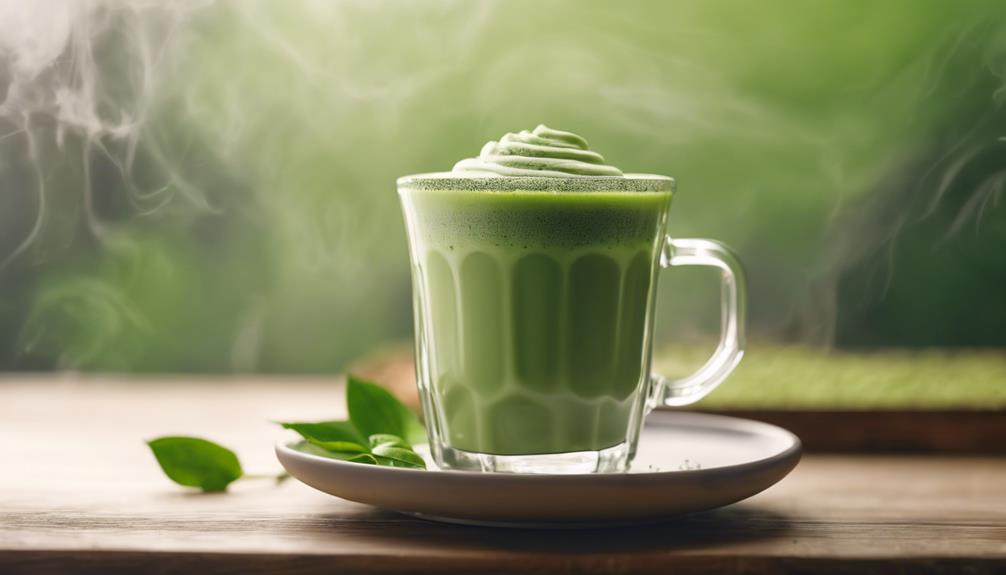Including iced coffee in your weight loss plan can aid in appetite control, offer a low-calorie alternative, and boost energy for calorie burning. Be cautious of hidden sugars in some iced coffee drinks that can hinder weight loss. Opt for low-calorie options and watch portion sizes to avoid excess calories. Experiment with flavorings like vanilla or cocoa powder and use sugar-free sweeteners. Try adding protein shakes for a balanced drink. Iced coffee can be a beneficial addition to your weight loss journey. Further insights await regarding choosing the right iced coffee, portion control tips, recipes, and incorporating it sensibly into your diet. Additionally, cold brew benefits include a smoother, less acidic taste and a higher caffeine content, making it a popular choice for iced coffee enthusiasts. When making your own iced coffee at home, consider using cold brew for a delicious and refreshing option. By being mindful of ingredients and portion sizes, you can enjoy the benefits of iced coffee as part of a balanced weight loss plan.
Key Takeaways
- Choose low-calorie iced coffee options.
- Add protein for satiety and muscle support.
- Be cautious of hidden sugars in iced coffee.
- Experiment with flavors and homemade recipes.
- Use portion control to avoid excess calories.
Benefits of Iced Coffee for Weight Loss
Iced coffee offers various benefits for weight loss, making it a valuable addition to your diet and fitness routine. When it comes to drinking coffee, opting for iced coffee can be a smart choice for weight management. With options containing as little as 15 calories, it can be a low-calorie alternative to sugary beverages. This can help in reducing overall caloric intake, supporting your weight loss goals.
Additionally, the energy boost provided by iced coffee makes it an excellent pre-workout drink. This boost can help you burn more calories during exercise, potentially enhancing your weight loss efforts. Moreover, iced coffee can aid in curbing appetite and reducing cravings, further contributing to your weight loss journey.
For a balanced and filling option, consider adding protein shakes or meal replacement drinks to your iced coffee. This combination can provide a satisfying drink to support your weight loss objectives effectively.
Potential Pitfalls of Iced Coffee
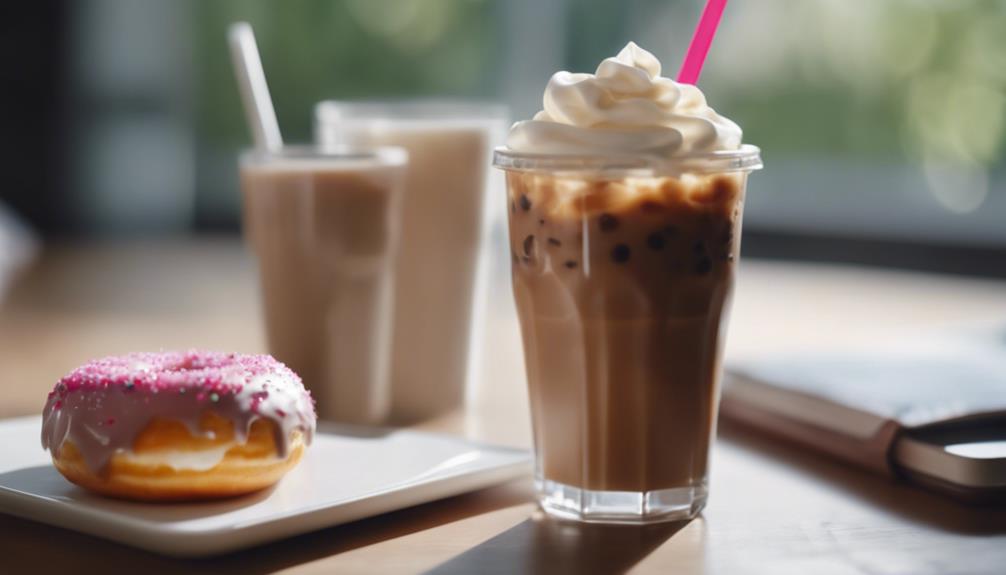
Keep an eye out for the hidden pitfalls of your favorite iced coffee drinks that could hinder your weight loss progress. While iced coffee can be a revitalizing choice, many coffee beverages available today come loaded with hidden sugars and high-calorie additives like syrups and creamers. These additions can quickly turn a seemingly innocent drink into a calorie bomb that offsets the potential weight loss benefits of the coffee itself.
Cafe-prepared iced coffees are particularly notorious for containing added sugars and excess calories, so it's crucial to be cautious when ordering these drinks. Additionally, pre-packaged iced coffee beverages often harbor hidden sugars and unhealthy ingredients that can sabotage your weight loss efforts.
Another pitfall to watch out for is portion sizes; consuming large quantities of iced coffee can result in an unintended calorie surplus. To avoid these pitfalls, always check the ingredients and portion sizes of your iced coffee choices to make sure they align with your weight loss goals.
How to Choose the Right Iced Coffee
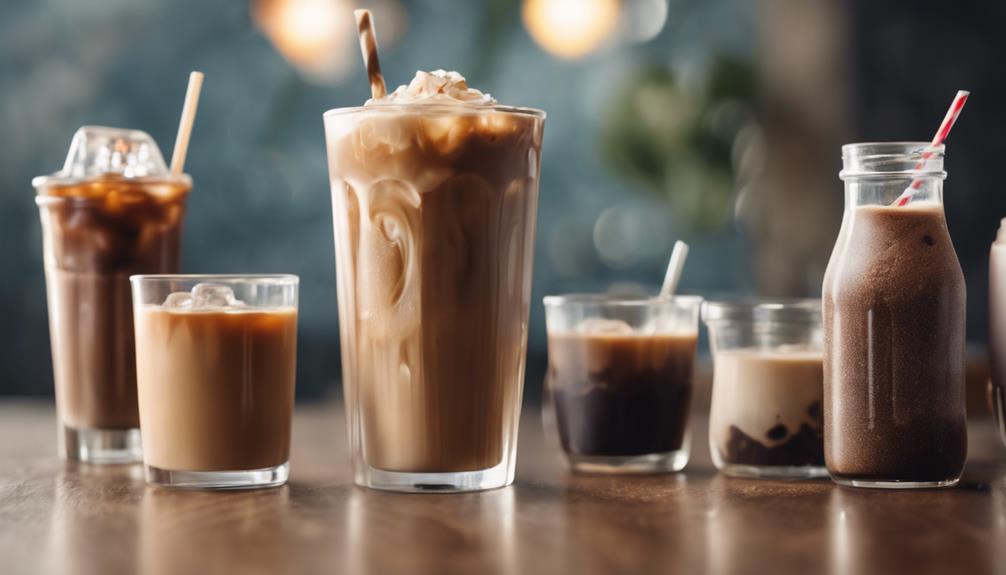
When selecting the right iced coffee, consider your flavor preferences, whether you prefer decaf or regular options, and the sweeteners and additives that align with your weight loss goals.
Pay attention to the ingredients in your iced coffee to make sure you're making a choice that supports your health objectives.
Flavor Preferences for Iced Coffee
Consider exploring various flavored options to enhance the taste of your iced coffee without adding extra calories. When choosing the right flavor for your iced coffee, remember to:
- Opt for vanilla or other flavored iced coffee options for a delightful twist without the guilt of additional calories.
- Experiment with instant espresso as a cost-effective choice to create delicious iced coffee right in the comfort of your home.
- Try adding chocolate protein shakes to your iced coffee for a flavorful and protein-rich addition that can keep you full and satisfied.
Decaf or Regular Options
To make the right choice between decaf and regular options for your iced coffee, consider how caffeine content can impact your taste preferences and overall wellness goals.
Decaf coffee contains a small amount of caffeine, making it a suitable choice for individuals aiming to lessen their caffeine intake while still savoring iced coffee. If you're sensitive to caffeine or desire to enjoy iced coffee later in the day without disturbing your sleep, decaf might be the better option for you.
On the other hand, regular iced coffee offers a higher caffeine content, which can potentially aid in boosting metabolism and supporting weight loss efforts. Opt for regular coffee if you require an energy boost or simply prefer the taste and aroma of caffeinated beverages.
Sweeteners and Additives
For a healthier and flavorful iced coffee experience, opt for sugar-free sweeteners like stevia or monk fruit to avoid unnecessary calories.
When choosing the right additives for your iced coffee, consider the following tips:
- Select sugar-free sweeteners: Steer clear of high-calorie sweeteners and opt for stevia or monk fruit to sweeten your drink without the added calories.
- Choose low-calorie milk options: Use unsweetened nut milks or low-fat dairy alternatives to keep your iced coffee light and lower in calories.
- Experiment with natural flavors: Enhance the taste of your iced coffee with natural flavors like cinnamon, vanilla extract, or cocoa powder for a delicious twist without the need for extra sugar.
Portion Control Tips for Iced Coffee
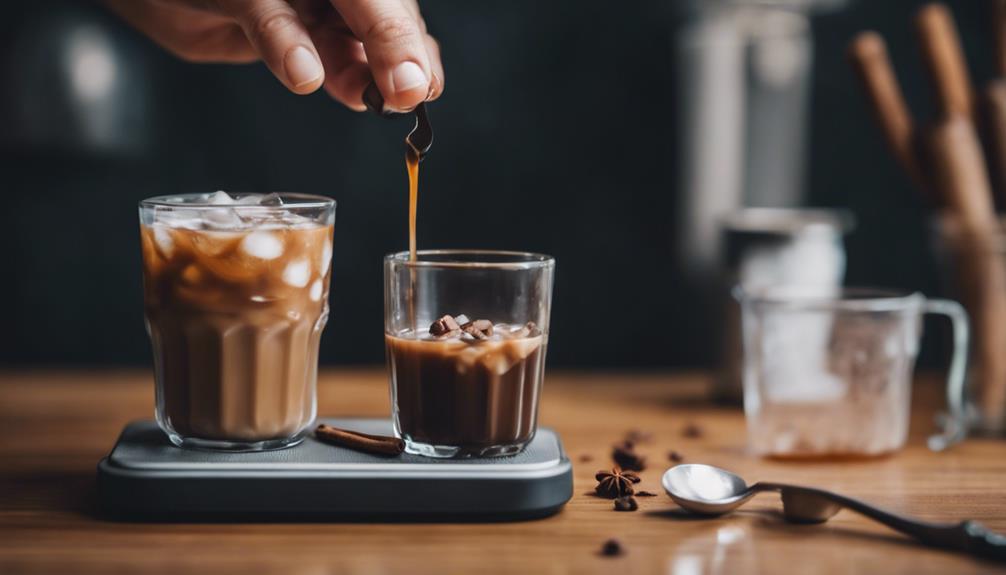
Using a smaller cup or glass is a practical way to control your portion size when enjoying iced coffee. By opting for a reduced vessel, you naturally limit the amount of coffee and additives you consume.
To further enhance portion control, carefully measure out the coffee, milk, and sweeteners, ensuring you don't go overboard. Consider selecting low-calorie or sugar-free options to keep the calorie count in check while still enjoying your iced coffee.
If you find your drink too potent, diluting it with water can help reduce the overall caloric intake. Remember to be mindful of toppings and add-ins such as whipped cream, syrups, and chocolate drizzles, as these extras can quickly add unwanted calories.
Iced Coffee Recipes for Weight Loss
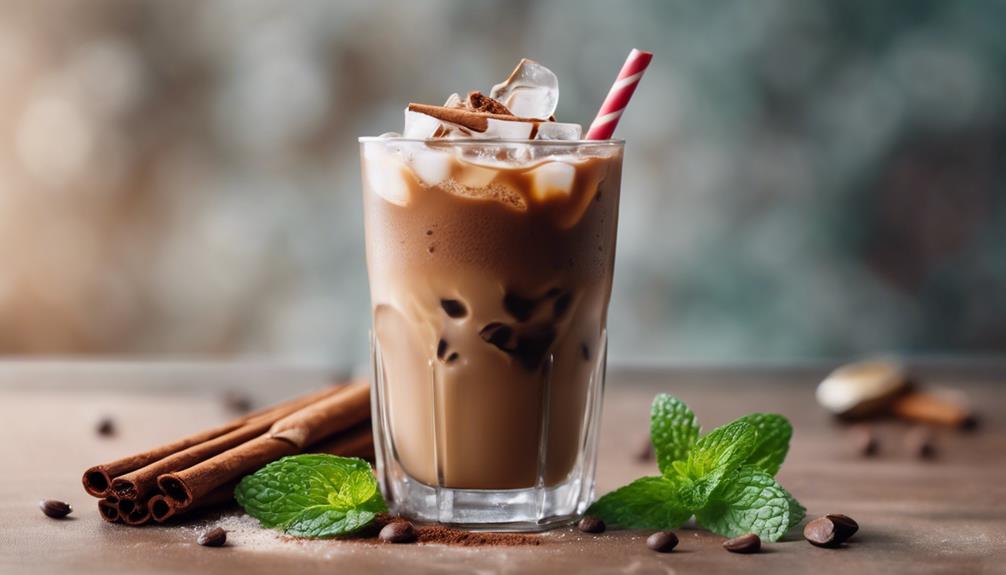
When it comes to iced coffee recipes for weight loss, there are various options to explore. Recipe variations and tips can help you create delicious yet healthy iced coffee drinks.
Highlighting the health benefits and allowing for ingredient substitutions can enhance your weight loss journey while enjoying your favorite beverage.
Recipe Variations and Tips
Consider experimenting with different recipe variations and tips to enhance your iced coffee experience for weight loss. Here are some ideas to help you create delicious and low-calorie iced coffee options:
- Add premier protein to your Starbucks iced coffee for a boost of protein without excess calories.
- Explore flavored coffee options such as vanilla or hazelnut to keep your drink interesting and satisfying.
- Use instant espresso as a cost-effective choice for making your own iced coffee at home.
Health Benefits Highlighted
Enhance your weight loss journey with these health benefits highlighted in iced coffee recipes. Drinking coffee can help you lose weight by suppressing appetite and reducing cravings, making it easier to stick to your dietary goals.
By incorporating low-calorie ingredients like premier protein or flavored coffee options into your iced coffee, you can enhance these weight loss benefits even further. Consider using instant espresso or chocolate protein shakes as cost-effective choices to boost your metabolism while enjoying a delightful beverage.
For a invigorating and low-calorie alternative to sugary drinks, whipped coffee sweetened with stevia can be a great option. Many users have reported significant success in their weight loss journey by simply incorporating iced coffee into their daily routine.
Ingredient Substitutions Allowed
Substitute regular cream with skim milk or unsweetened nut milk in your iced coffee to lower calorie intake while still enjoying a creamy texture. By making simple ingredient swaps, you can support your weight loss journey without sacrificing flavor.
Consider these additional substitutions to enhance the health benefits of your iced coffee:
- Use sugar-free sweeteners like stevia or monk fruit instead of sugar to cut down on empty calories.
- Opt for low-calorie or zero-calorie flavorings like vanilla or cinnamon to add a delicious twist without the extra sugar.
- Incorporate protein shakes or premier protein in your iced coffee to increase satiety and boost the drink's nutritional value.
Making these ingredient substitutions can help you manage your calorie intake and reduce the risk of sugar cravings throughout the day, allowing you to enjoy multiple cups of iced coffee per day guilt-free.
Incorporating Iced Coffee Into Your Diet

Looking to add an invigorating twist to your diet while managing your weight? Incorporating iced coffee can be a revitalizing and low-calorie option for those trying to lose weight. With just around 15 calories in a typical 16-ounce serving, iced coffee can be a great alternative to high-calorie beverages. Adding protein to your iced coffee, such as with Premier Protein shakes, can help you stay full longer and support muscle maintenance during weight loss. Experiment with flavored options like vanilla or hazelnut to keep the calorie count low while adding variety to your routine. Instant espresso is a convenient choice for making iced coffee at home, providing a quick energy boost without the excess calories. Whipped coffee, made with instant coffee and a sugar substitute, can be a delicious treat without the added sugars found in traditional coffee drinks.
| Tips for Incorporating Iced Coffee Into Your Diet: |
|---|
| 1. Opt for low-calorie variations |
| 2. Add protein for satiety |
| 3. Experiment with flavored options |
| 4. Consider using instant espresso or whipped coffee |
Iced Coffee Vs. Other Beverages for Weight Loss
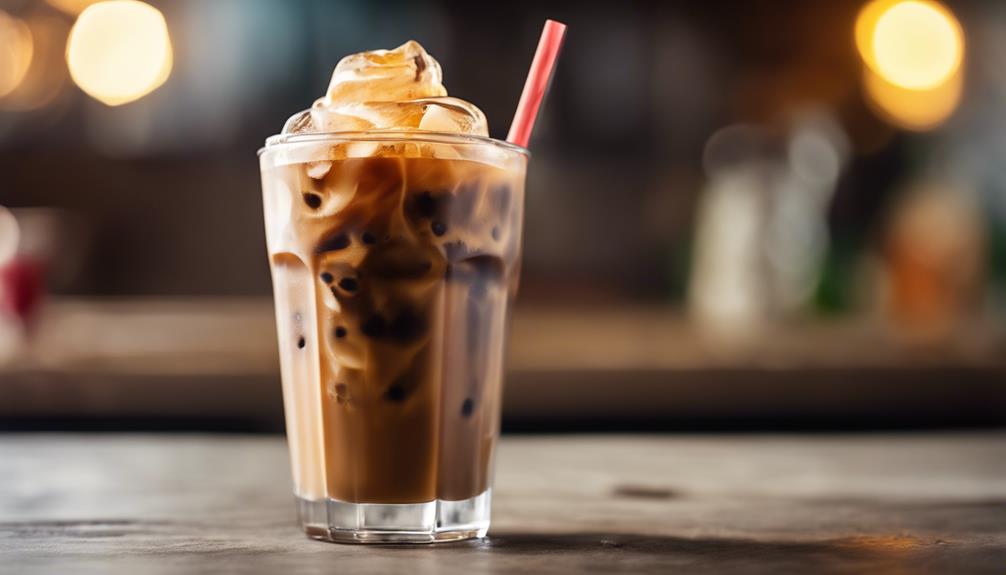
Consider iced coffee as a favorable option over high-calorie beverages when aiming for weight loss goals. When comparing drink options, iced coffee stands out due to its low-calorie content and potential benefits for weight loss. Here are some reasons why choosing iced coffee can be advantageous:
- Low-Calorie Content: Iced coffee typically contains fewer calories than sugary drinks, making it a suitable choice for those working towards weight loss.
- Appetite Control: Drinking coffee, whether hot or iced, can help curb appetite, assisting in managing food intake and supporting weight loss efforts.
- Energy Boost: Iced coffee provides an invigorating way to get a caffeine boost, which can enhance your energy levels during workouts and throughout the day.
When it comes to losing weight, opting for iced coffee over calorie-laden beverages can be a smart choice. Next, we'll explore the best practices for incorporating iced coffee into your weight loss journey.
Best Practices for Drinking Iced Coffee
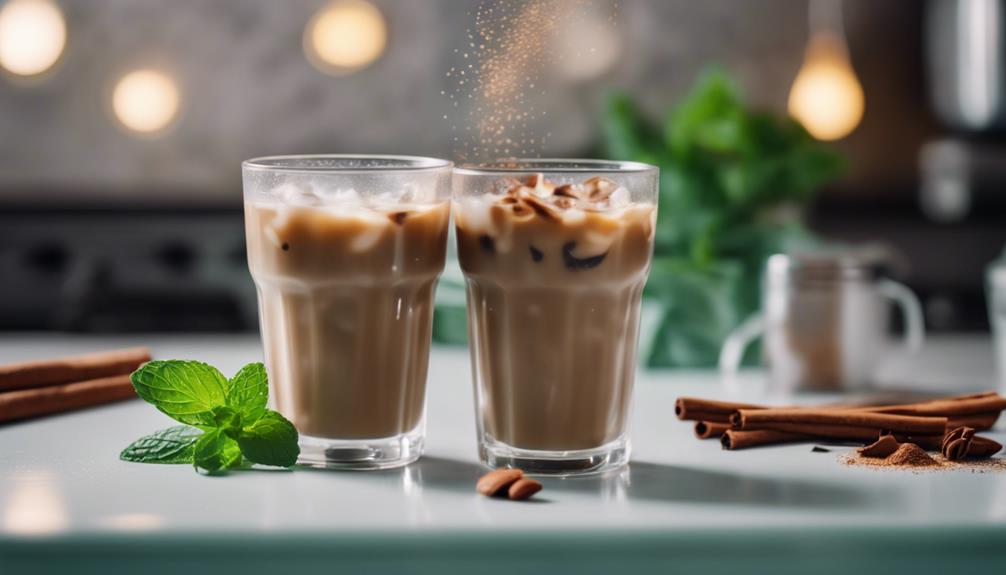
To make the most of your iced coffee for weight loss, here are some best practices to keep in mind.
When drinking iced coffee, be cautious of potential weight gain by opting for low-calorie options such as Starbucks iced coffee paired with premier protein, which contains only 15 calories.
It's crucial to make sure your iced coffee remains weight loss-friendly by experimenting with different flavors like instant espresso or chocolate protein shakes.
If you enjoy sweetness in your coffee, try whipped coffee with stevia as a sugar substitute to keep the calorie count in check.
Frequently Asked Questions
Can I Drink Iced Coffee While Trying to Lose Weight?
Yes, you can drink iced coffee while trying to lose weight. A typical 16 oz serving contains around 15 calories, making it a low-calorie option.
Adding protein shakes or flavored syrups can help curb your appetite. Some individuals have reported successful weight loss by incorporating iced coffee into their diet.
Opt for sugar substitutes like stevia to enhance the weight loss benefits. Experimenting with different brands and flavors can make iced coffee an invigorating tool for your weight loss journey.
Will I Lose Weight if I Start Drinking Coffee?
You'll likely lose weight if you start drinking coffee, as it can help with weight loss by suppressing appetite, stimulating thermogenesis to burn calories, and aiding in calorie burning during workouts.
Combining coffee with water can also help you feel fuller for longer.
However, for best results, make sure you maintain a balanced diet and incorporate regular exercise alongside coffee consumption to support your weight loss efforts effectively.
What Is the Best Coffee Order for Losing Weight?
For weight loss, opt for black iced coffee to keep calorie intake low.
Add unsweetened almond or coconut milk for creaminess without extra calories.
Avoid sugary syrups and flavored creams that increase calorie content.
Try sugar-free sweeteners like stevia or monk fruit for sweetness.
Boost energy and potential appetite suppression with a shot of espresso or protein powder.
Stick to these choices to support your weight loss goals effectively.
Which Cold Coffee Is Best for Weight Loss?
When considering cold coffee for weight loss, opt for iced black coffee as the lowest-calorie choice. Enhance the flavor by adding unsweetened almond or coconut milk.
Cold brew coffee, with its smooth taste, is a great option. Avoid sugary syrups and choose natural sweeteners like stevia or monk fruit.
For added protein and satiety, consider mixing in a splash of protein shake or collagen peptides. These choices can support your weight-loss goals effectively.
Conclusion
To sum up, integrating iced coffee into your weight loss journey can be a revitalizing and enjoyable way to boost your metabolism and curb cravings. By selecting the right type of iced coffee and practicing portion control, you can enjoy the advantages of this popular beverage.
Keep in mind, moderation is crucial, and always consult with a healthcare professional before making significant changes to your diet. Stay hydrated, stay mindful, and savor your iced coffee responsibly on your journey to a healthier lifestyle.

